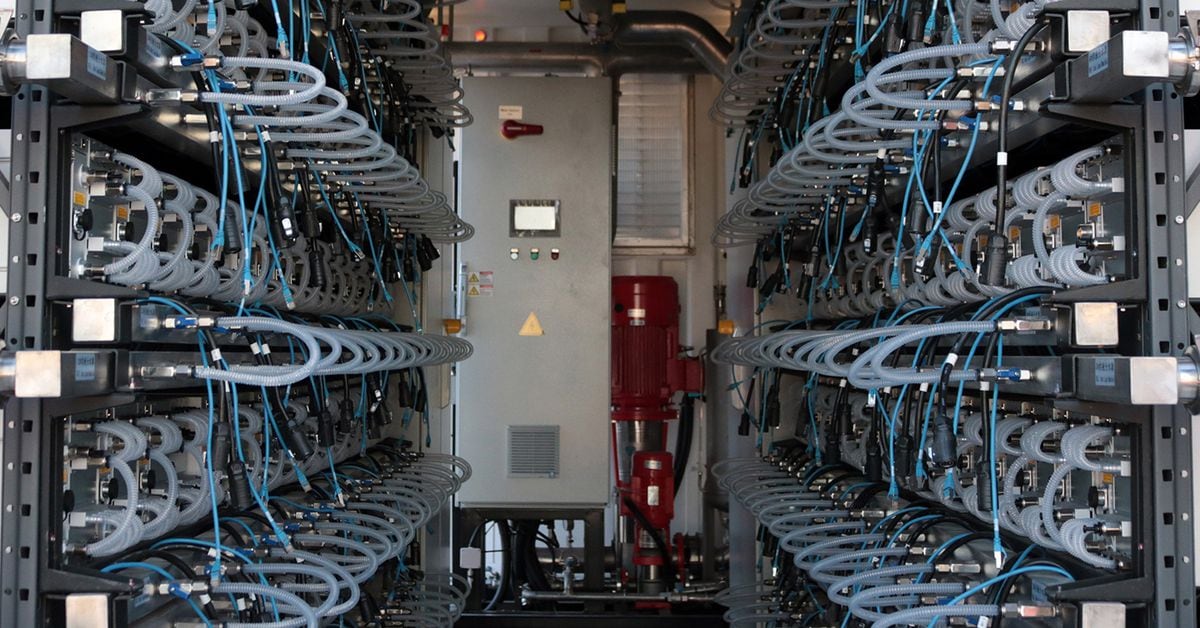The White House’s Bitcoin Mining Tax Is Undermining Itself

In its bid to marginalize the domestic crypto industry, the White House has unleashed financial regulators, deployed the banking sector and generally harassed crypto firms here. On top of that, it is now trying to push through a de facto ban on mining in the US with the Digital Asset Mining Energy (DAME) excise tax. The proposed levy would add 30% to miners’ electricity costs, which would be enough to turn their finances upside down and force them to leave these shores.
CoinDesk columnist Nic Carter is a partner at Castle Island Ventures, a public blockchain-focused venture fund based in Cambridge, Mass. He is also the co-founder of Coin Metrics, a blockchain analytics startup.
The tax sets an extremely dangerous precedent, as it singles out an industry that legally buys electricity, and holds the electricity buyers responsible for the carbon emissions of the underlying generation. This makes no sense. It is not the responsibility of bitcoin miners to decarbonize the electricity they buy – that falls to the architects of the grid. If the Biden admin can’t get the grid to be sufficiently green, it should focus on that instead of punishing an industry that buys less than a single percentage point of the electricity produced in the United States in a given year. In addition, the proposed tax may not even be legal. Appeal lawyer W. Aaron Daniel has argued persuasively that Bitcoin mining is protected speech under the First Amendment and that a mining ban unfairly singles out miners, as New York State has already done.
Other industries are not held accountable for network spills in this way, only politically unfavorable ones like Bitcoin miners. If this precedent is set, every politically disaffected energy consumer will potentially be in the crosshairs. I could easily imagine the next DAME tax targeting data centers running insufficiently awake AI models, or data centers running uncensored social media servers. And in a future, possible Trump administration, who’s to say he wouldn’t use a similar approach to cut power to abortion clinics, left-leaning universities, Disney World, the NY Times, or other industries or companies he dislikes? In this country, resources like electricity should be available to all, not used as a political cudgel to attack specific industries.
As for the tax itself, it doesn’t even achieve its stated goals. In fact, it achieves the exact opposite of what the architects envisioned.
The aim of the tax is as follows:
But the tax would actually do the following:
First, and most importantly, taxing US mining does not mean less Bitcoin mining overall. Bitcoin mining is a highly competitive industry, and miners are incentivized to bring capacity online as long as the economics are favorable. China’s ban on Bitcoin mining in 2021 did not result in less Bitcoin mining – the miners simply left China (for the most part) and set up shop elsewhere (including the US). Hashrate temporarily dropped after the ban, then roared back to double its pre-ban level. The mighty US government is impotent in this matter. It cannot persuade the miners to discard their ASICs. It will just mine somewhere else.
In fact, many miners who used abundant hydropower in Yunnan or Sichuan provinces moved to Kazakhstan, which has a high fossil energy power grid. Today, the US accounts for about 30-40% of global Bitcoin mining (the best data we have comes from Cambridge University, but it’s somewhat dated and imprecise). The most popular other countries are, in rough order, China (yes, despite the ban there is about a 17% hash rate in China), Russia, Canada, Kazakhstan, Indonesia, Paraguay, Norway and Venezuela. We also know that Bitcoin mining directly funds the governments of Russia, Iran, Venezuela and North Korea. These regimes use Bitcoin mining for sanctions evasion, to turn their mineral wealth into cash. Attacking domestic miners in the US hashrate simply means that other miners are more profitable online, because their share of the pie is larger.
Supporting the coffers of these direct opponents should hardly be a goal of the Biden administration, but that’s what the DAME tax would do.
The authors of this treasure—I have been told that the principal man is Heather Bouchey from the White House Council of Economic Advisors—recognizes that miners can freely move abroad, undermining their policies. But they seem to be laboring under the naïve delusion that governments globally will impose similar taxes on Bitcoin miners. This is wishful thinking in the extreme. Biden Admin claims that “China completely banned such activity in 2021,” but we know that there is still meaningful Bitcoin mining in China. And the Biden Admin, who has fewer friends abroad by day, can hardly expect other jurisdictions to move in lockstep with them. The US’s loss is Russia’s, Iran’s, China’s and Venezuela’s gain. Additionally, the Biden admin has repeatedly called for more transparency regarding miner emissions and energy impact – they have clear access to that data if miners are based here in the US, but virtually no insight if those miners are native to China or Russia .
And if you look at the emissions profile of these alternative residences for miners, almost all of them (with the exception of Paraguay, Norway, and possibly Canada) are characterized by a higher carbon intensity in their generation than the American American generation, combined, is 379 g/CO2e, against 544 g/CO2e for China, 742 g/CO2e for Kazakhstan, 360 g/CO2e for Russia, 623 g/CO2e for Indonesia and 493 g/CO2e for Venezuela.
These numbers are indicative only, as in practice mining in the US is generally cleaner than the generic land-level grid. There is significant mining, for example, in West Texas, which has large amounts of wind and solar, for which there is insufficient transmission. Other US mining hotspots include hydroelectric mining in New York state, hydro in the Appalachians, natural gas/nuclear in Ohio and PA, and stranded flare gas in Wyoming, Montana and the Dakotas. (Extraction with otherwise flared gas is actually carbon negative overall).
As for the alleged “costs” that Bitcoin miners impose on communities, this argument is highly questionable. Bitcoin miners are just data centers. They do not produce pollutants or toxic waste. Usually, miners are out of the way in rural areas where electricity is cheap. Due to the laws of physics, electricity doesn’t travel well, so miners powering rural West Texas aren’t depriving someone in Dallas of power.
The net effect of the presence of Bitcoin miners on a modern grid is to cut off the tails of the price distribution: they scoop up cheap (or even negatively priced) power when no one is buying it—helping utilities make better money—and they turn off when electricity is expensive, and provides power back to households during grid shortage events. Miners actively participate in “demand response” or “controllable load” programs in grids that have them, helping to stabilize grids since they have a unique ability to react quickly to changing grid conditions and turn consumption up and down as needed. During the network load last winter and in summer 2022 in Texas, the miners turned down their consumption, so that energy could flow back to ordinary households. It’s no wonder Texas Governor Greg Abbott has praised miners for their benevolent presence on the ERCOT grid.
The flexibility of mining from a location perspective is so great that a number of miners, such as Iris Energy or Terawulf, are able to make the exclusive use of renewable energy part of their corporate mandate – something virtually no other industry can match. And there are some miners like Aspen Creek that explicitly support the development of new, additional renewable energy sources as part of their mission. Any solar or wind installation it helps fund will also provide decarbonised power to ordinary households. This is hardly something the Biden Admin can complain about.
More broadly, the administration’s stance, as revealed by the DAME tax, reveals its technologically regressive de-growth agenda. Biden officials are not happy with Bitcoin miners using pure power, preferring to try to ban the industry altogether.
Bitcoin miners have the prospect of helping stabilize increasingly renewable grids and even financially support new wind and solar installations. They can create a new model of location-agnostic data centers that are co-located with renewable generation, rather than relying on the old hub-and-spoke model that requires costly transmission. Bitcoin miners are pioneering the model of bringing demand to the generation source, but other industries will follow, such as green hydrogen, fertilizer production, and eventually other forms of computing.
In addition, if the Biden administration wants to implement its “electrify everything” plan, which is a necessary component of decarbonization, it will often take several more generations than we have today. Someone has to pay for this. How is a new source of demand for electricity, especially renewable energy, considered a bad thing?
The Biden administration’s rejection of an energy buyer that is location-agnostic, interruptible, and uniquely suited to buy new renewables is totally at odds with its own stated goals for the transformation of the grid. As for the tax, it achieves none of its stated goals, and strengthens America’s enemies. Clear-eyed politicians should reject it outright.
Thanks to Ethan Vera for his contribution to this article.
























